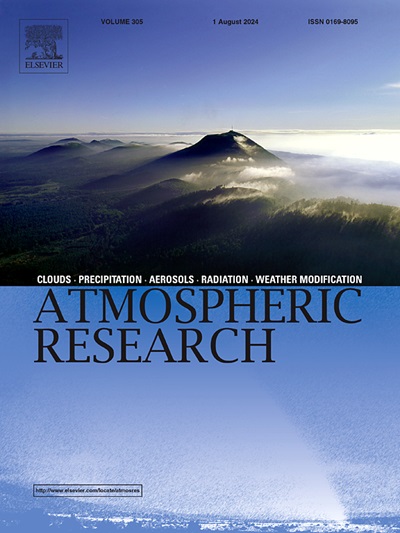Gradient variations of formation mechanisms and sources of PM1 at the steep slope from western SiChuan Basin to eastern Tibetan Plateau
IF 4.4
2区 地球科学
Q1 METEOROLOGY & ATMOSPHERIC SCIENCES
引用次数: 0
Abstract
Vertical distributions of chemical components of particulate matter (PM) are essential for better understanding the climate, environmental and health effects. The steep slope from western SiChuan Basin (SCB) to eastern Tibetan Plateau (TP) provides a good platform for obtaining the gradient variations of PM chemical components. Daytime and nighttime PM1 (particulate matter smaller than 1 μm) samples were collected with the medium-volume sampler at six sites with elevation ranging from 500 m to 3500 m (Chengdu, Sanbacun, Wenchuan, Lixian, Maerkang and Hongyuan). The secondary inorganic ions and carbonaceous aerosols were the largest contributor to PM1 concentrations. The chemical components from the anthropogenic sources existed strong stratification with high concentrations inside the basin, while primary natural ions showed little discrepancy among the sites. The concentrations of primary inorganic ions from anthropogenic sources were much higher at nighttime than daytime, which was contrary to the diurnal cycle of secondary inorganic ions. Spatial heterogeneity of PM chemical components was large between basin and plateau sites, especially for NO3− and NH4+, large depending on season and daylight. The excess NH4+ concentrations existed in spring, summer and fall, while SO42− and NO3− cannot be completely neutralized by NH4+ in winter. The proportion of secondary formation in all sources significantly increased from about 10 % to 30 %–40 % with the increased elevation, while the contribution of motor vehicles declined from western SCB to eastern TP. This study will fill the scarce observations of PM chemical components at the sloped terrain and deepen the understanding of formation mechanism of heavy pollution inside the basin.
四 川 盆 地 西 部 至 青 藏 高 原 东 部 陡 坡 地 区 PM1 的 形 成 机 理 和 来 源 的 梯 度 变 化
颗粒物(PM)化学成分的垂直分布对于更好地理解气候、环境和健康影响至关重要。从四川盆地西部到青藏高原东部的陡坡为获得可吸入颗粒物化学成分的梯度变化提供了一个良好的平台。在海拔 500 米至 3500 米的 6 个地点(成都、三坝村、汶川、理县、马尔康和红原)使用中型采样器采集了白天和夜间的 PM1(小于 1 μm 的颗粒物)样品。二次无机离子和碳质气溶胶是 PM1 浓度的最大来源。人为来源的化学成分在盆地内存在较强的分层现象,浓度较高,而原生天然离子在各站点之间的差异不大。人为来源的原生无机离子浓度在夜间远高于白天,这与次生无机离子的昼夜周期相反。可吸入颗粒物化学成分的空间异质性在盆地和高原站点之间很大,尤其是 NO3- 和 NH4+,因季节和日照而异。在春季、夏季和秋季,NH4+浓度过高,而在冬季,SO42-和NO3-不能完全被NH4+中和。随着海拔的升高,所有来源中二次形成的比例从约 10% 显著增加到 30%-40%,而机动车的贡献则从 SCB 西部向 TP 东部下降。该研究填补了坡地可吸入颗粒物化学成分观测的空白,加深了对盆地内重污染形成机理的认识。
本文章由计算机程序翻译,如有差异,请以英文原文为准。
求助全文
约1分钟内获得全文
求助全文
来源期刊

Atmospheric Research
地学-气象与大气科学
CiteScore
9.40
自引率
10.90%
发文量
460
审稿时长
47 days
期刊介绍:
The journal publishes scientific papers (research papers, review articles, letters and notes) dealing with the part of the atmosphere where meteorological events occur. Attention is given to all processes extending from the earth surface to the tropopause, but special emphasis continues to be devoted to the physics of clouds, mesoscale meteorology and air pollution, i.e. atmospheric aerosols; microphysical processes; cloud dynamics and thermodynamics; numerical simulation, climatology, climate change and weather modification.
 求助内容:
求助内容: 应助结果提醒方式:
应助结果提醒方式:


